NVIDIA Shield Review: At the Crossroads of PC and Mobile Gaming
by Brian Klug on July 31, 2013 12:14 AM EST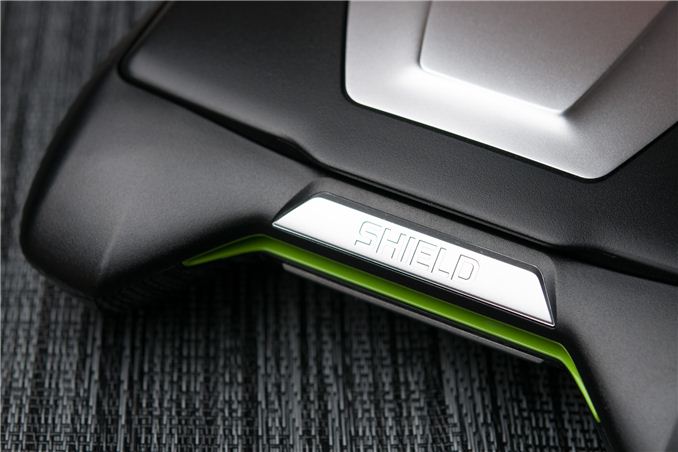
NVIDIA is doing something different with Tegra 4, very different. To bring up its silicon, each vendor usually makes a reference design phone and tablet with a selection of approved components, packages a BSP (Board Support Package), and ships that and some engineers to customers. Rather than never letting the reference design see the light of day, this time NVIDIA also made it into something they can sell directly, a portable gaming device called Shield.
It’s no secret that Tegra 4 isn’t exactly the success that NVIDIA probably hoped it would be. While the initial word was that Tegra 4 had an obvious set of design wins following momentum from products which shipped in 2012 through 2013 with Tegra 3, but it’s obvious that Shield will now effectively serve as NVIDIA’s launch vehicle for Tegra 4.
Shield is an aspirational product and not an easy one to nail down – enthusiasts are picky about controllers, Android gaming is still largely an unknown, and the question remains what presence handheld gaming consoles will have in the future. To answer all those questions NVIDIA sent over Shield, a Falcon Northwest Tiki with GTX 760 inside, and Parrot AR Drone 2.0 for us to review. Read on for the full story.
Introduction and Hardware
With Shield, NVIDIA gave us a rare glimpse into some of the stages of design. When Anand and I saw Shield at CES, it was more of a prototype than real, reviewable sample of the portable gaming device. The analog sticks weren’t weighted right, the plastic felt somewhat creaky, the triggers and bumpers felt hollow and strange, and the D-Pad worked, but not amazingly so. It was exactly what you’d expect from a prototype, and as Shield inched closer to final release the hardware got successively better and better, until the final unit dropped on our doorstep.
The hardware that is the shipping Shield today is a world better, it’s everything I was hoping Shield would end up being in terms of a controller, with the right balance and in-hand feel.
There’s so much scrutiny on the fit and finish of mobile devices these days, for NVIDIA to build a mobile device and gaming controller at the same time invites a whole new level of scrutiny, potential issues, and things to get tuned just right. I’ve purchased a few high end gaming controllers in my day (like a kitted out $125 Scuf FPS Competition Xbox 360 controller that I love), but hesitate to review them because of just how much there is to talk about, and how much of it comes down ultimately to taste.
Anand and I gave feedback to NVIDIA early on that they should arguably use the Xbox 360 controller as something of a baseline for tuning their controller components. With the Shield what we get is nearly exactly that. The analog trigger resistance, bumper clickiness, and analog stick friction feel remarkably like the 360, perhaps just a tad less. I consider the 360 controller out of the box nearly perfect, but some of that is adaption and familiarity versus being some global maxima for perfection. At the same time, if the PS3 controller is your bar, you’re probably going to have a bad time initially with Shield until you’ve adapted. Where Shield does borrow somewhat from the PS3 controller is the analog stick positioning, which is bottom center, instead of opposed top left and bottom right. One of my initial complaints was that my thumbs can collide with each other when left stick is at limits to the right, and right stick is at limits to the left (a complaint about the PS3 I have as well). NVIDIA seems to have spaced these a bit more and my thumbs aren’t quite hitting as much as they were previously.
Since the display has to close flat on the control surface, some of the shape is gated by the limitation that you can’t have the analog sticks or buttons ramming through the display, so they’re sunken down a bit. The rest of the interface (A/B/X/Y, NVIDIA, Back, Home, Start, Volume and D-Pad) rest roughly in the same plane. The spring preload on the buttons is great, though I wish they were maybe a touch less mushy for A/B/X/Y, and although I’m not much of a platform gamer, the D-Pad feels so much better now than it did before.
The shape of Shield fits in my hands really, really well. The bottom is a grippy, rubberized material that grabs the hands well and plants the Shield solidly on any surface you put it down on. The interesting shape on the back side, means I can rest my middle finger in a sort of folded position along the inside (something you can’t do with most wireless controllers) and it feels great. I have no issues with the mass of Shield fatiguing my hands or feeling awkward since it’s so well balanced and ergonomically shaped down there.
On the front of Shield is a green-tinted intake and grille for the device’s active cooling. When I first heard that Shield had active cooling I was a bit shocked, but it turns out to be completely unobtrusive in actual use.
With Shield open you can see the 5-inch 720p display surrounded by a somewhat large bezel. This remains my only complaint about Shield – I wish it had a slightly larger display that took up more of the fold-out area. Below that are stereo speakers that go loud (I love that stereo is now a feature showing up in more devices) and in the very middle is a microphone.
On the back of Shield are its I/O ports, which are microUSB 2.0, mini-HDMI, headphone jack, and microSDXC. There’s also the exhaust grille for Shield’s active cooler back here. Above the microUSB 2.0 port is a small charge status LED which is amber while plugged in and charging, and green when fully charged. I remain confused by the choice of mini-HDMI, when smartphones and tablets have universally adopted the microHDMI format plug, and I’m buried in those cables compared to a relative scarcity of mini-HDMI ones, though NVIDIA has shipped mini-HDMI GPUs before.
On the top of Shield is, well, a small shield, which NVIDIA calls a tag. This snaps onto the top and adds a bit of a customization option, it’s held in place with magnets. Out of the box the tag is a metallic silver material. It looks great but I’ve already managed to put a few hairline scratches into it, which leads me to my next point.
NVIDIA has a carrying case option available, but it really needs to give some kind of carrying case away with Shield. Although Shield feels really well constructed, right down to even the hinge mechanism, I’d like a better way to protect it, especially while traveling. I know I’m going to put more scratches into the silver tag while traveling with Shield in my bag, for example.
Shield’s in-hand feel is really, really good. NVIDIA seems to have nailed the device on the controller side, which is no small task considering this is their first attempt. As a handheld mobile device, it’s definitely on the large side, but it’s hard to really say anything negative about it since this is an entirely new form factor. Other smartphone solutions with a foldable control scheme on the phone are similarly bulky, the upside is with Shield it’s all packaged better. Again my only wishes from a purely hardware perspective would be an in-box case, bigger display, and inclusion of a front facing and rear facing camera of some kind – if nothing else for video chat and taking photos when you’ve got the Shield already in your hand.
| SHIELD (P2450A) | |
| SoC | NVIDIA Tegra 4 - 1.9 GHz |
| Display | 5-inch 1280x720 "Retinal" Display |
| RAM | 2 GB LPDDR3 |
| Wireless Connectivity | 2x2:2 802.11a/b/g/n WiFi + BT 3.0, GPS |
| Storage | 16 GB NAND total, microSD Expansion |
| I/O | microUSB 2.0, mini-HDMI, 3.5mm headphone, |
| OS | Android 4.2.1, Updates from NVIDIA |
| Battery | 28.8 Whr |
| Size / Mass | 158 x 135 x 57 mm, 579 grams |
| Buttons | Dual Analog Joysticks, D-Pad, Left/Right analog trigger and bumpers, A/B/X/Y buttons, Volume, Home, Back, Start, NVIDIA Power/Multifunction |
The hardware specs are pretty well understood at this point. There’s a Tegra 4 SoC inside working the 4 ARM Cortex A15s at up to 1.9 GHz (and one shadow core for low power), 72 GPU cores in that SoC, 2 GB of LPDDR3 RAM, 16 GB of built in flash, and 2x2:2 (yes, two stream) 802.11a/b/g/n WiFi from a BCM43241 combo which we’ve written about before.


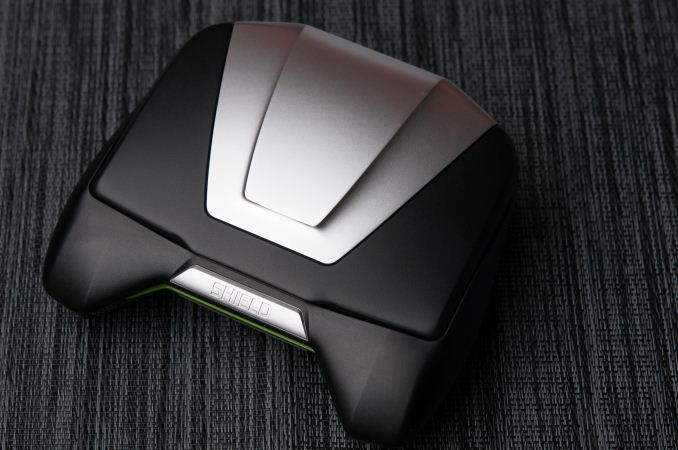
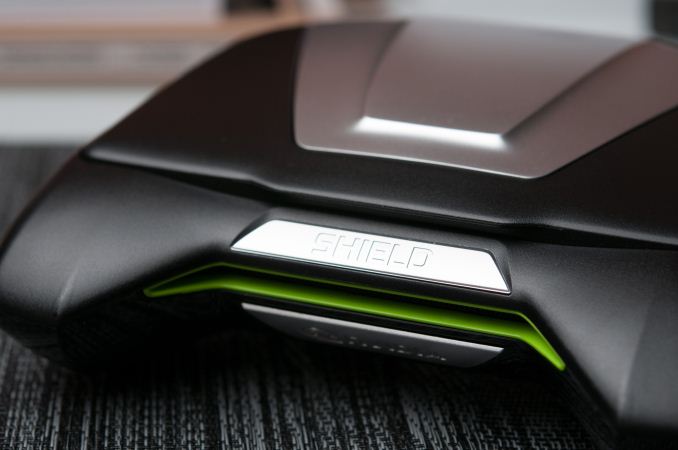


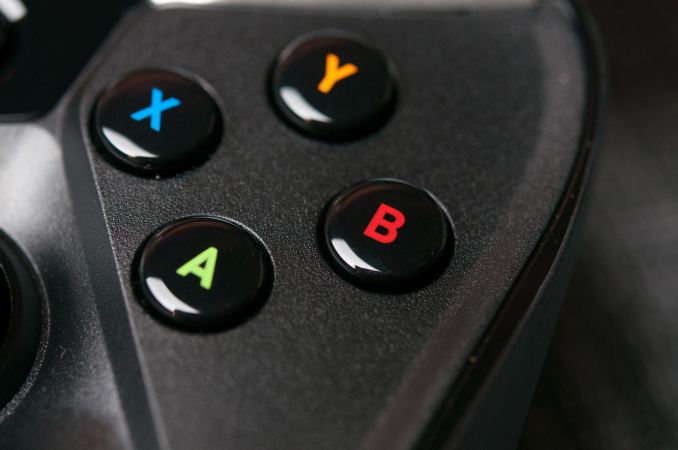
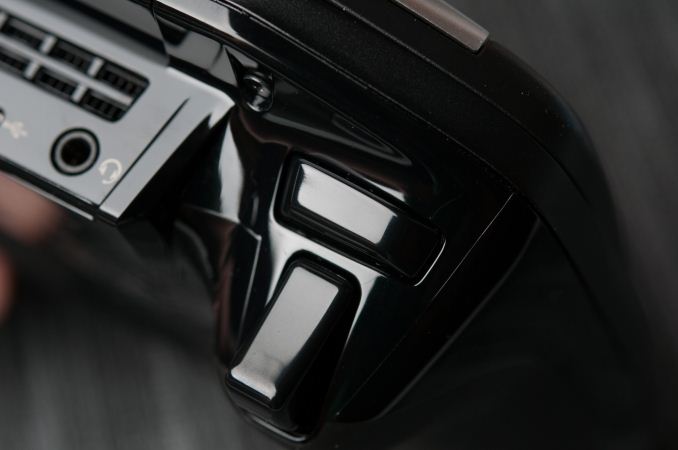
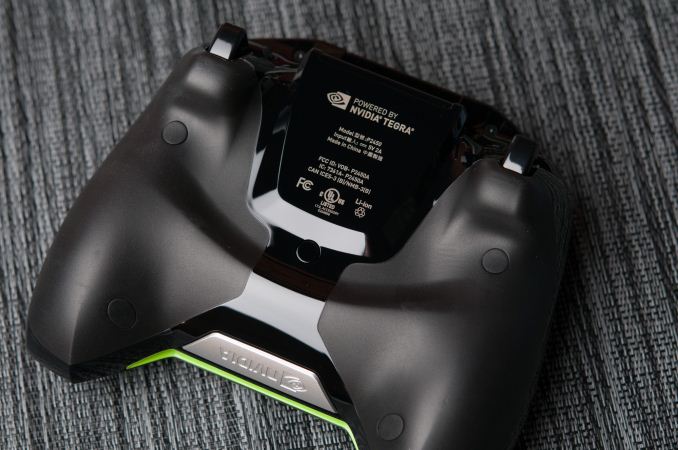
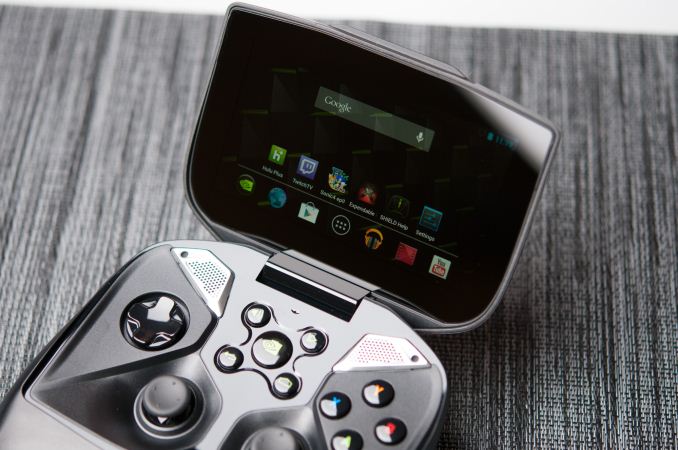
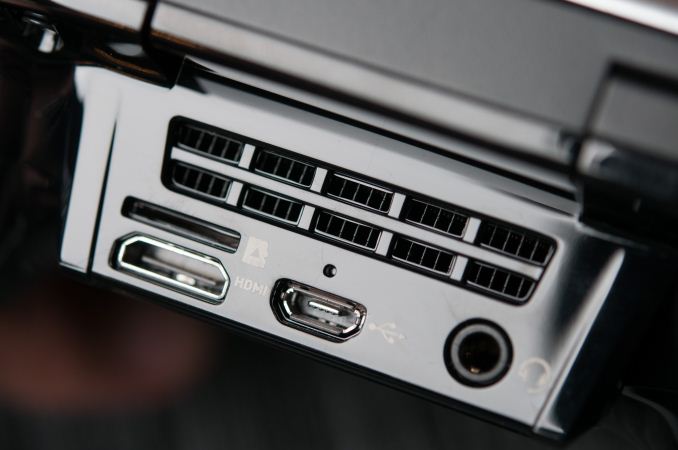
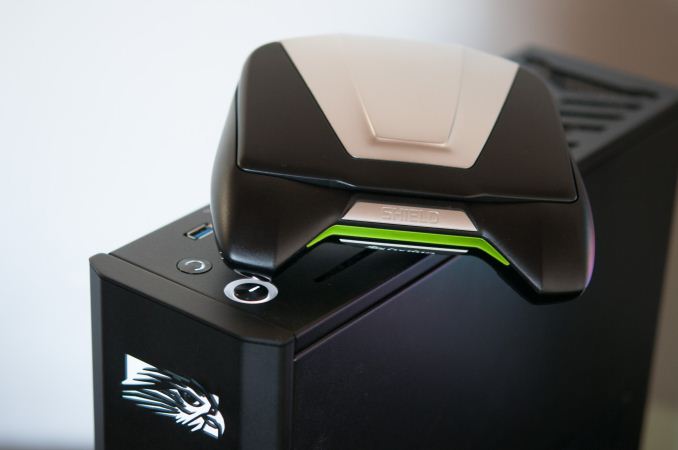














134 Comments
View All Comments
darkich - Wednesday, July 31, 2013 - link
..-there is hundreds of thousands of them.
- there are many full pc game ports already
- as far as shooters(genre with the greatest benefit of analog controls) are concerned, the iOS/Gplay library is VASTY superior, with at least ten super cheap titles that are at the same time better than ANY shooter on the DS/Vita.
Get out of that reality distorted prism and open your eyes already, please.
nikon133 - Wednesday, July 31, 2013 - link
So... do you get heavy hitters on Shield (and in general for Android/iOS), games like:Rayman Origins
LittleBigPlanet
Mortal Combat
Metal Gear Solid HD collection
Uncharted
Dead or Alive 5
Street Fighter X Tekken
NFS: Most Wanted
Wipeout 2048
Ninja Gaiden
Jak and Daxter Collection
I have noticed some AAA titles in Android Market Place / Apple AppStore, but many of them seem to be dumbed down versions of console/PC counterparts, sometimes not much more than same name. On Vita, most above mentioned games are very close to originals from big consoles.
Yes they are much more expensive, but there really is reason for that. I do have Android tablet and iPhone, and had iPad for a while as well... but no, I failed to find many - if any - games of same overall quality you can get on PSP, let alone Vita.
darkich - Thursday, August 1, 2013 - link
Unbelievable short sightness..The uncharted and (ridiculously overrated) fighter games ate pretty much only titles I give to you, in that list.
And you missed the Assasin's creed title, while at it.
iOS/Android?
The crazy thing is, those libraries are so superior there really cannot be a comparison even.
There are HUNDREDS OF THOUSANDS OF GAMES ON MOBILE, more titles being released in a day than what comes out in a month on Vita.
Picking up individual ("casual") titles that have amazed millions of players would take ages, but alright, I'll just try to pick up some of the "highest production quality" ones.
I dare you to find Vita counterparts to.these:
- Infinity blade
- Galaxy on fire
- Max Payne
-GTA
-Deus Ex: The Fall
- Order and Chaos
- The Bard's Tale
- Star Wars: Knights of the Old.Republic
- Bastion
- XCOM: Enemy Unknown
- Six Guns
- Modern Combat (4)
- N.O.V.A. (3)
- Real Racing (3)
- The Dark Knight Rises
- Sentinel III
- Shadowgun: Dead Zone
- Battle Bears
- Blitz Brigade
- Sky Gamblers(personal favorite)
- NBA 2k 13
- Chaos Rings
..
And I could go on, and on.
I hope you realize you've been beaten in your own game now.
Overall, iOS and Android game libraries are simply beyond comparison superior, offering hundred times more quantity, at a bargain price.
The reason why it seems the Nintendo and Vita have more quality is because the libraries are tiny and don't get flooded and burried up with thousands upon thousands of casual titles
darkich - Thursday, August 1, 2013 - link
..oh, and last and the most important..the FUTURE TRENDS.Android and iOS gaming will only grow-in fact, it is yet to enter the real revolution, with major studios tasting serious profits on the freemium model and taking mobile seriously (EA, for example, will release frostbite games on Android and iOS next year), and mobile GPU's far outperforming the PS3 console in a less than a year.
Otoh, Vita and Nintendo DS will simply fade into complete irrelevance.
nikon133 - Thursday, August 1, 2013 - link
Uncharted and fighting games only..?I will respectfully disagree. MGS Collection, Ninja Gaiden, Jak and Daxter are all premium titles. As well as LittleBigPlanet, one of most original franchises in recent years.
I didn't compile list of best games, I just listed bunch of games I recall that were well reviewed. Beside Assassin Creed, I also missed
Sly Cooper: Thieves in Time
MLB 13: The Show
Disney Epic Mickey 2: The Power of Two
Muramasa Rebirth
Velocity Ultra
Dragon's Crown
Guacamelee!
Soul Sacrifice
PlayStation All-Stars Battle Royale
Persona 4 Golden
Zero Escape: Virtue's Last Reward
Doruko
FIFA 13
FIFA 14
Final Fantasy X
Gravity Rush
Madden NFL 13
...
... and I could go on and on.
True, Vita and GB are missing variety of cheap casual titles, so if one's preference in gaming is tossing birds and piggies across the screen, then it is simple choice.
But for premium, PC/console-quality titles? No. Not yet, at least. Those are still too few for Android/iOS. And of those that do exist, many are riddled with poor control schemes or poor execution in general.
darkich - Friday, August 2, 2013 - link
Which games from my list have you played, and on what device?5150Joker - Tuesday, August 6, 2013 - link
NVIDIA: Thanks for the review! The check is in the mail! :DSeriously, who in their right mind would buy this oversized piece of junk?
Jumangi - Wednesday, July 31, 2013 - link
Yea and the vast majority of them are that cheap for a reason.Jumangi - Wednesday, July 31, 2013 - link
Those 2 inches matter allot to people. The form factor matters allot to people(bulky controller with flip screen and a fan going vs a sleek tablet like the new Nexus 7) The Nexus gets great battery life too. The power means nothing if it can't be used and I doubt much their will ever be and real support for the thing.Its has no future.
Someguyperson - Wednesday, July 31, 2013 - link
I'm really torn whether to get this, or the new Nexus 7. I feel that half my time using a portable device is reading online articles and the other half playing emulators, but I might be leaning towards this guy. $300 isn't cheap enough for an impulse buy though.